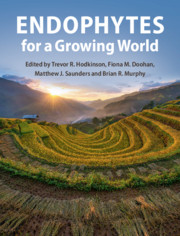Book contents
- Endophytes for a Growing World
- Endophytes for a Growing World
- Copyright page
- Contents
- Contributors
- Preface
- Part I Introduction
- Part II Role of Endophytes in Growth and Biotic and Abiotic Stress Resistance
- Part III Diversity and Community Ecology of Endophytes
- Part IV Endophytes for Novel Biomolecules and In Vitro Methods
- 13 Endophytic Fungi: A Quintessential Source of Potential Bioactive Compounds
- 14 Enhancing Secondary Metabolite Production in Medicinal Plants Using Endophytic Elicitors: A Case Study of Centella asiatica (Apiaceae) and Asiaticoside
- 15 In Vitro Methods for Plant–Microbe Interaction and Biocontrol Studies in European Ash (Fraxinus excelsior L.)
- Part V Application and Commercialisation of Endophytes in Crop Production
- Index
- References
13 - Endophytic Fungi: A Quintessential Source of Potential Bioactive Compounds
from Part IV - Endophytes for Novel Biomolecules and In Vitro Methods
Published online by Cambridge University Press: 01 April 2019
- Endophytes for a Growing World
- Endophytes for a Growing World
- Copyright page
- Contents
- Contributors
- Preface
- Part I Introduction
- Part II Role of Endophytes in Growth and Biotic and Abiotic Stress Resistance
- Part III Diversity and Community Ecology of Endophytes
- Part IV Endophytes for Novel Biomolecules and In Vitro Methods
- 13 Endophytic Fungi: A Quintessential Source of Potential Bioactive Compounds
- 14 Enhancing Secondary Metabolite Production in Medicinal Plants Using Endophytic Elicitors: A Case Study of Centella asiatica (Apiaceae) and Asiaticoside
- 15 In Vitro Methods for Plant–Microbe Interaction and Biocontrol Studies in European Ash (Fraxinus excelsior L.)
- Part V Application and Commercialisation of Endophytes in Crop Production
- Index
- References
Summary
The fortuitous discovery of penicillin from Penicillium chrysogenum heralded the golden era of antibiotics. Since then, fungi have significantly contributed to the welfare of humans by producing bioactive compounds which have been used as antibacterial, anticancer, antioxidant and immunomodulatory agents. However, in recent years, microorganisms associated with plants have emerged as fountainheads of bioactive molecules with high therapeutic potential. In general terms, endophytes are an extremely diverse and ubiquitous group of microorganisms that resides within the living internal tissues of a host plant in a non-invasive manner. Endophytes communicate with their host plant through metabolic interactions which enables them to produce signal molecules with interesting biological activities. Further, the genetic recombination of endophytes with the host plant enables them to mimic the biological properties of the host and produce analogous bioactive compounds. Thus, they start producing the host plant phytochemicals when cultured independently. The endless need for potent drugs has prompted researchers to explore alternative avenues for finding novel bioactive molecules, and endophytes appear to be a plausible target for drug discovery. This chapter reviews the current research trends with these promising organisms.
- Type
- Chapter
- Information
- Endophytes for a Growing World , pp. 277 - 309Publisher: Cambridge University PressPrint publication year: 2019
References
- 5
- Cited by

